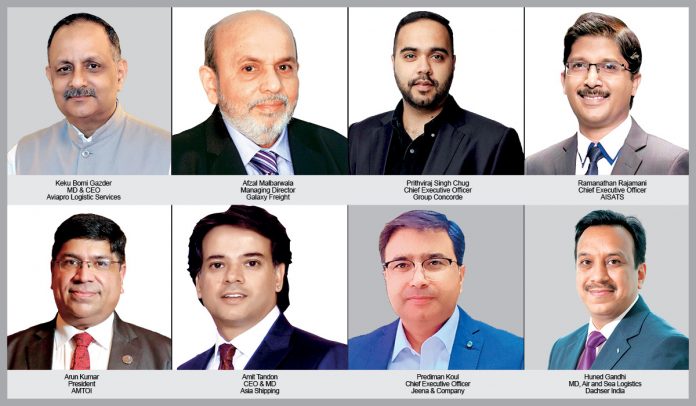With PMGS and NLP streamlining multimodal link and attracting global investment, the world is eyeing India due to its location, expanding manufacturing base and logistics infra. As companies diversify supply chains beyond China, India stands out with export potential, booming e-commerce and focus on digital and sustainable logistics — positioning itself as vital player in the future of global cargo movement.
Ritika Arora Bhola
The world is witnessing India as a pivotal player in the air cargo and logistics landscape. From rising exports to investments in infrastructure, the world’s leading logistics operators, cargo terminal investors and technology solution providers are placing long-term bets on Indian influence on global freight movement.
With government initiatives, such as ‘Make in India’, PMGS, NLP, Sagarmala and Self-Reliant India, the nation is strengthening its logistics backbone and positioning itself as an alternative in global cargo corridors — a move that has caught the attention of industry leaders worldwide.
Aircraft manufacturers, such as Boeing or Airbus, mobile phones major, Apple, international retail brands and consumer durable firms, have all established manufacturing plants across India. Why? Because of the growing potential and trust of foreign investors in the Indian market.
The country’s proximity to growing consumer markets in Southeast Asia along with trade routes to Europe and Africa have given India an edge to become a regional cargo powerhouse. Investments are being channelised into developing multimodal logistics corridors, inland water transport and dedicated freight corridors (DFCs) to capitalise on this advantage.
The global push for China+1 strategies is giving pace for transfer of manufacturing plants to India, which resulted in demand for reliable, scalable and cost-efficient cargo and logistics. MNCs, cargo terminal operators (CTOs) and logistics solution providers are finding new opportunities to invest in and partner with Indian players to cater to this fast-growing movement of goods.
Situated between the East and the West, India serves as a natural bridge for global cargo flows, especially across Asia, the Middle East, Africa and Europe. With access to 7,500 km of coastline, 13 major ports, 200 non-major ports and a rapidly developing network of airports and dry ports, India has the potential to serve as a transshipment hub and is a vital logistics gateway.
Major airports, such as Delhi, Hyderabad, Mumbai and Bengaluru, are providing best-in-class transhipment facilities. Many new regional airports operating under the Airports Authority of India are also gearing up to become cargo and logistics hubs.
Major international cargo carriers are enhancing their capacity and frequency to Indian cities. Indian airports, regional and international, are developing integrated cargo terminals, transshipment facilities and cold-chain zones. With volumes on the rise from exports and e-commerce, global cargo players are increasingly entering into JVs and partnerships with Indian businesses.
India’s economic growth is no longer confined to metros. Tier II and III cities are becoming new centres of trade, manufacturing, and consumption. This decentralised growth is expanding the need for regional cargo terminals, air freight corridors and logistics parks across the country.
PMGS, which aims to build 300 multimodal logistics parks (MMLPs) across India, has so far been successful in its target plan. Gati Shakti Cargo Terminals for rail freight are being constructed to facilitate improved rail cargo movement. National Highways, DFCs, and SEZs are fostering growth and EoDB.
The PMGS platform ensures faster clearance and coordination across ministries, encouraging investment in logistics infrastructure. The PPP models and PLI Schemes along with NLP provide a framework for reducing logistics costs from 13 to 14 per cent of GDP to single digits, aligning the country with international standards. These reforms give foreign investors the confidence that India is serious about becoming a world-class logistics hub.
Additionally, India’s e-commerce boom has created a demand for fast, efficient and technology-driven cargo solutions. With 800 million internet users and a rising middle class, the demand for same day and next day deliveries has accelerated the growth of regional air cargo networks, express logistics and last-mile delivery, say reports. Firms, such as Amazon, DHL, FedEx, and UPS are expanding their operations and infra in India, while players, such as Delhivery, Ecom Express and Blue Dart are leveraging global investments to scale rapidly.
The e-commerce-led segment presents an opportunity for foreign investors, logistics startups and platform enablers to enter or expand within the country’s dynamic supply chain ecosystem. Digitisation and automation are creating opportunities for global technology providers. From AI-powered warehouse management systems and cargo tracking tools to IoT-enabled fleet monitoring and paperless customs clearance, the shift toward smart logistics is unlocking new investment avenues.
Sustainability is steadily becoming a key priority. The public and private sectors are investing in EV fleets, solar-powered warehouses, green terminals and carbon-efficient cargo practices. For global investors focused on Environmental, Social and Governance (ESG) metrics, India’s evolving green logistics landscape offers compelling reasons to invest.
Several logistics giants have announced multi-million-dollar investments in India. For instance, DP World, Maersk and Amazon are investing in inland container depots, fulfilment centres and cargo terminals. According to experts, sovereign wealth funds, private equity firms and institutional investors are betting on India’s cargo infrastructure as a long-term, high-yield opportunity. For global companies, this means that India offers not just one but multiple high-growth cargo markets.
Regional airports are being upgraded with air cargo handling capabilities and states are launching their own logistics policies to attract investment. The opportunity to scale air cargo networks in emerging cities is drawing attention from foreign as well as domestic investors. India’s large, young and tech-savvy workforce is another asset. With a pool of logistics professionals, IT engineers and supply chain specialists, India provides the human capital needed to operate modern cargo systems.
In parallel, India’s vibrant technology startup ecosystem is driving innovation in freight booking, route optimisation, cargo finance and predictive logistics. This creates multiple synergies for global investors who can find a market and a partner ecosystem for collaborative growth. India’s cargo growth story is not just about numbers — it is about momentum, reform and long-term strategic advantage. From policymakers and private investors to global corporations and startups, everyone has a role in shaping India into a major global cargo hub. With the right investments, partnerships and continued policy support, India is positioned to lead the next decade of growth in cargo and logistics — not just for itself, but as a key driver in the international supply chain network.
Speaks to logistics experts on the opportunities that lie ahead and if India is the right choice for foreign investors?
India has access to key international routes
Keku Bomi Gazder, MD & CEO, Aviapro Logistic Services
India’s logistics market is more attractive as compared to Southeast Asia. Valued at over US$ 400 billion, it is projected to grow due to rising e-commerce, infra development, PMGS and NLP. India’s geographic location offers strategic access to key global trade routes, while investments in MMLPs, DFCs and digital logistics platforms enhance efficiency. India offers a larger domestic market and lower labour costs. Even though Vietnam, Thailand and Malaysia often score higher in EoDB. India’s long-term potential remains strong — making India a favourable logistics hub with room for improvement.”
Air, rail, road infra improve connectivity
Afzal Malbarwala Managing Director, Galaxy Freight
The air cargo sector is being seen as a lucrative bet for freight operators and other stakeholders. In 2023–2024, India saw a 7 per cent YoY rise in volumes handled by Indian airports, while global loads spiked by 10 per cent. Not only air, as far as road and rail infra are concerned, expressways and highways are reducing transport time and improving connectivity. Union Minister Nitin Gadkari recently stated that within two years, India’s road infrastructure will be comparable to that of the USA. The DFCs are also an effort to increase rail freight share and leverage rail network to lower logistics costs.”
India becoming logistically competitive
Prithviraj Singh Chug, Chief Executive Officer, Group Concorde
India has scale in terms of consumption and production. Unlike many Southeast Asian markets, India offers a broader cargo basket. With Make in India, PMGS and investments in multimodal connectivity, India is becoming logistically competitive. From a GSA perspective, we see a long-term commitment from global carriers to India. Though it has geographical advantages, especially for South Asia, Middle East and East Africa flows, we need more than location to become a transshipment hub. What is needed is more coordination between customs, airport authorities and carriers.”
India must overcome logistical bottlenecks
Ramanathan Rajamani, Chief Executive Officer, AISATS
India’s goal to reduce logistics costs to under 10 per cent of GDP is facilitated by reforms such as the NLP, which seeks to streamline processes and improve efficiency. The country’s digital ransformation, highlighted by ULIP, offers real-time cargo tracking, and enhanced transparency. Challenges such as customs processes, regulatory fragmentation and logistical bottlenecks remain, while Southeast Asian nations such as Singapore and Malaysia have progressed by leaps and bounds. Despite these challenges, India’s expanding infra investments position it to outpace its competitors in the long run.”
Policies & PPP to make India an international hub
Arun Kumar, President, AMTOI
To unlock India’s advantage, infrastructure enhancement and regulatory simplification is must. China has built the most efficient logistics networks over the past two decades. Logistics thrives as a core economic activity in Singapore, Hong Kong. Malaysia, Vietnam, and Thailand have taken after their successful neighbours. India may have joined the race late, but it has the scale, demographic dividend and domestic demand that many of its peers lack. With focus, coherent policy implementation and PPP, India has the capacity to emerge as an international logistics hub.”
Chinese firms eyeing India to relocate
Amit Tandon, CEO & MD, Asia Shipping
We are witnessing an uptick in logistics demand as many companies are diversifying from manufacturing in China. With a massive consumer market and skilled labour, India is becoming the go-to hub for sectors such as electronics, pharma and automotives. Initiatives such as PLI Scheme and the ongoing port infra upgrades are also fuelling this growth. Recent reports show more companies are eyeing India for relocation compared to other nations. The China+1 strategy is a golden chance for the country to cement its role in international supply chains, and we are thrilled to be part of this dynamic shift.”
India logistics hub for domestic needs
Prediman Koul, Chief Executive Officer, Jeena & Company
As global companies look to diversify beyond China, India is emerging as a strong alternative due to initiatives such as Make in India and PLI that encourage domestic production and invite investment. Our skilled labour is set to meet the demands and is more accessible than that of other countries. This makes India appealing to sectors that need specialised professionals. Enhanced port facilities, industrial corridors and SEZs have made exporting from India efficient. These factors position India as a logistics hub for domestic needs and a compelling gateway for global trade.”
Country stands out for consumer-driven economy
Huned Gandhi, MD, Air and Sea Logistics Dachser India
Global companies are diversifying their manufacturing and sourcing bases across Asia due to ever-evolving geo-political developments. As a result, countries such as India, Vietnam, Thailand and Indonesia are being integrated deeply into global value chains. Each location offers advantages, whether in terms of cost, infra, trade pacts or workforce capabilities. India is positioning itself as a reliable long-term partner in automotive, pharma, textiles, garments and electronics. While Southeast Asia has witnessed traction due to existing trade ties, India’s investment in infra is creating long-term advantages.”















